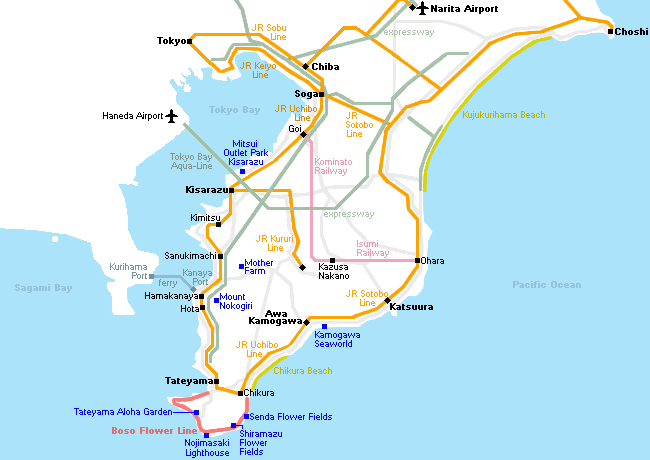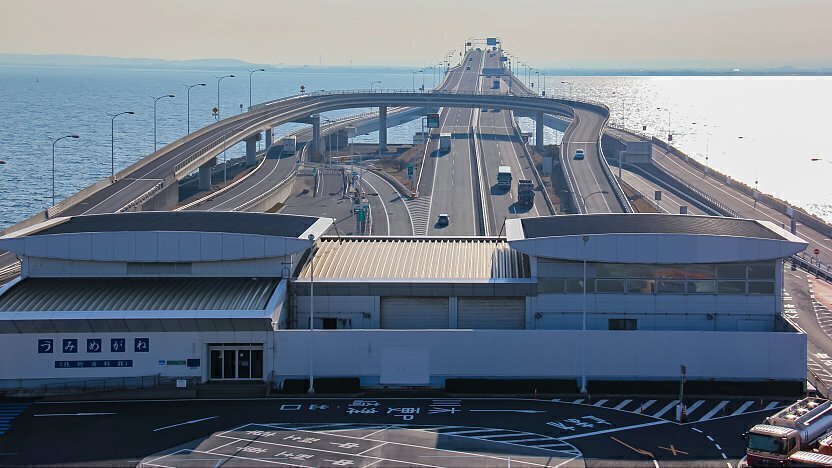Boso Peninsula: Getting there and around
How to get to the Boso Peninsula from Tokyo
By limited express train
JR Wakashio limited express trains connect Tokyo Station with Awa-Kamogawa Station along the eastern coast of the Boso Peninsula. Along the western coast, JR Sazanami limited trains travel as far as Kimitsu, except on selected days during the peak seasons when some trains run all the way to Tateyama. The one way trip from Tokyo down the Boso Peninsula takes one to two hours and costs 2500 to 4000 yen, depending on how far you travel. Seat reservations are mandatory. The trains are fully covered by the Japan Rail Pass and the JR Tokyo Wide Pass.
By local trains
Travel by local trains between Tokyo and the Boso Peninsula requires a change at typically Chiba or Soga Station where you can catch a train along the JR Uchibo Line down the western coast or along the JR Sotobo Line down the eastern coast. The one way trip takes 90 minutes to four hours and costs 1300 to 2500 yen, depending on how far you travel. The trains are fully covered by the Japan Rail Pass, JR Tokyo Wide Pass and Seishun 18 Kippu.
By highway bus
Highway buses provide direct access from Tokyo Station to various parts of the Boso Peninsula, including Tateyama and Kamogawa (2 hours, 2500-2800 yen one way, 1-2 buses per hour on each line). In addition, there are some buses from Haneda Airport via the Tokyo Bay Aqua Line expressway onto the Boso Peninsula, including buses to Kisarazu (40 minutes, 1400 yen one way, 1-3 buses/hour) and Tateyama (100 minutes, 2700 yen one way, every 1-2 hours).
By ferry
The Tokyo Bay Ferry connects Kurihama on the Miura Peninsula with Kanaya on the Boso Peninsula, not far from Mount Nokogiriyama. Ferries operate roughly hourly and take 40 minutes to make the crossing. The one way fare is 1000 yen for passengers and around 4900 yen for a regular-sized car.
Above fees and schedules are subject to change. Be sure to check current yen exchange rates.
Getting around
The Boso Peninsula is a large peninsula, stretching about 100 kilometers from north to south and 50 kilometers across at its widest point. Most of the peninsula's cities are located along the coast while large parts of the interior are mountainous, forested and rural.

Relatively frequent JR train lines run along the peninsula's entire coastline: the JR Uchibo Line along the western coast and the JR Sotobo Line along the eastern coast. An additional JR line and two non-JR railway lines run from the coast into the peninsula's interior and provide beautiful rural scenery along their tracks. Sightseeing spots that are not near a train station can usually be reached by bus, but note that connections are not always very frequent.
While public transportation on the Boso Peninsula is overall quite decent, a rental car does provide additional comfort and flexibility, especially in the more remote areas. In order to avoid driving in Tokyo, it can be a good idea to take a train out of the metropolitan jumble and rent a car from a station closer to or on the peninsula. Many major train stations in the area have rental car outlets, including Soga, Kisarazu, Kimitsu and Tateyama Stations.
Expressways leads as far south as Tateyama and make getting around relatively quick. The absence of expressways in the southeast of the peninsula makes driving there a little bit more time-consuming. Part of the peninsula's expressway network is the Tokyo Bay Aqua Line, a 14 kilometer long expressway that spectacularly leads across Tokyo Bay half by tunnel and half by bridge. A rest area, called Umihotaru, is located at the point where the tunnel and bridge meet.

Questions? Ask in our forum.


